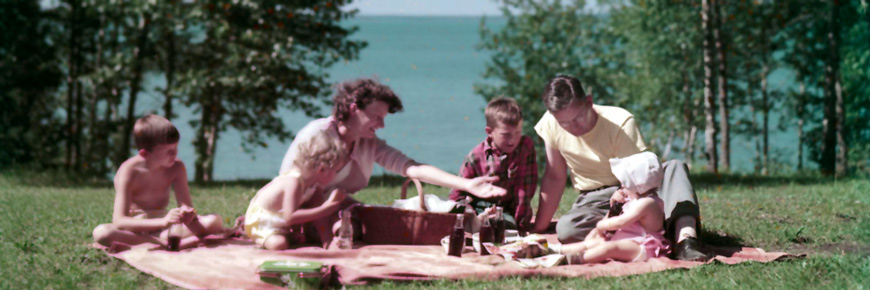
A family picnic at Waskesiu Lake, Prince Albert National Park, in July, 1950.
National Film Board of Canada
Early History of Recreation and Leisure
Prince Albert National Park
For many residents of Saskatchewan, Prince Albert National Park is a seasonal home away from home. Politicians and park staff in the early years promoted the value of the natural landscape as a place for weary city dwellers to rest and rejuvenate. Generations of visitors have returned year after year, like migratory birds.
Many of the scenic modern trails in the park have their origins in historical routes and paths. For example, until the early twentieth century, the Tait Springs Freight Trail was a part of a larger transportation route for goods and people that went from the city of Prince Albert to Montreal Lake and beyond. Other park infrastructure were built by Depression-era relief workers and Second World War conscientious objectors, including Highway 263. In fact, Highway 263 was deliberately built with as many curves as possible, deviating from the old freight trail’s original straight, flat route, to make it more scenic.
Construction of the resort town of Waskesiu boomed in the 1930s. Waskesiu has over half a dozen heritage buildings, including the Superintendent’s Residence (1930), the Terrace Gardens dance hall (1931), the Golf Course Club House (1934), the Nature Centre (1935), and the Community Hall (1937).
In the early decades of the park’s history, it was considered a “poor man’s paradise”, a place where residents of Saskatchewan could have an inexpensive but long and restful summer holiday. The low cost of camping permits meant that the park grew in popularity even during the Great Depression. The town site of Waskesiu was already bustling in the 1930s and had a loyal group of families who returned year after year to camp for weeks or months at a time. Swimming lessons were held off the breakwater near the main beach. Guided hikes, swimming and boat races, as well as golf and sport tournaments filled people’s days. There was even a highly anticipated annual pageant put on by the children of the camping community. Visiting bison in the Buffalo Paddock near South Gate was a must-see activity from 1933, when the park got its first display herd of plains bison, to 1997, when the paddock was removed to focus resources on the free-ranging Sturgeon River Plains Bison Herd. Visiting the bears scavenging in the park’s garbage dump was another opportunity to see wildlife, though attitudes and regulations around feeding wildlife have long since changed. Overall, with visitors staying long-term in summer from its early days, a sense of community was established early on in the park’s history.
The history of this territory did not begin with tourists in the early 20th century. Click below to learn more about this region prior to 1927:
- Date modified :